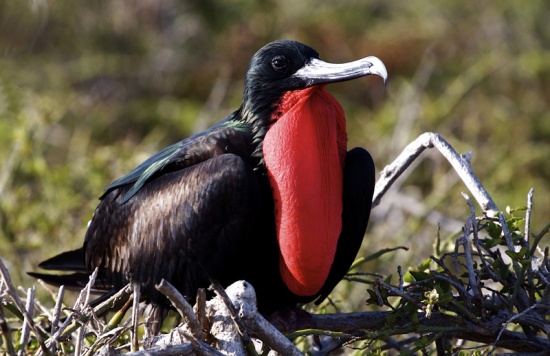- Fregata minor
Identification

Photo © by Ronald B. Davis
Darwin Bay, Isla Genovesa, Galapagos Islands, Ecuador, 1 February 2006
82–105 cm (32¼-41¼ in)
Male:
- Black with green gloss
- Red pouch expanded when displaying
- Often paler line diagonal on upper wing
- Red or reddish-brown legs and feet (difficult to see)
Female:
- Mostly black
- White on throat and upper breast, reaching almost the bill (very little dark in chin area)
- Red eye-ring
Juvenile:
- Mostly black
- White on breast
- Yellowish/orange/tawny on head and and upper breast (this may fade due to sun, but usually still visible on central breast)
Similar species
Other Frigatebirds. The adult male is almost identical to the adult male of the Magnificent Frigatebird. Differences include the brown carpal bar on the upper wing (present on Great, missing on adult Magnificent), and more greenish iridescence on the back of Great, more purple on Magnificent (this difference not always reliable). Great is also a somewhat smaller bird, and tends to forage out to sea avoiding coastal waters inhabited by the larger Magnificent Frigatebird. Female Great can be distinguished from the female Magnificent, by its pink, not blue orbital ring.
Distribution
Widespread tropical Pacific, Atlantic and Indian Oceans. Accidental to the United States with records in Oklahoma and off the coast of California.
Taxonomy
Subspecies
Five subspecies are recognized[1]:
- F.m. palmerstoni:
- Breeds islands in w. and central Pacific
- F.m. ridgwayi:
- Breeds e. Pacific on Revillagigedo, Cocos and Galapagos Islands
- F.m. nicolli:
- Breeds Tinidade Is. and Martin Vaz Is.; ranges to Brazil
- F.m. aldabrensis:
- Breeds w. Indian Ocean on Aldabra and adjacent islands
- F.m. minor:
- Cocos and Christmas Is. (Indian Ocean); Paracel Is. (S. China Sea)
Habitat
They breed in mangos on remote tropical islands, otherwise mainly pelagic.
Behaviour
Diet
Their diet consists mostly of fish, particularly flying fish.
Breeding
Clutch is one whitish egg. The nest is a large platforms of loosely woven twigs. The chicks are dependent on the adults for nearly a year after hatching, an exceptionally long time for any bird.
Vocalisation
Usually silent except at breeding colonies. May give grating calls when excited.
Movements
Mostly sedentary. Immatures and non-breeders disperse through tropical seas.
References
- Clements, J. F., T. S. Schulenberg, M. J. Iliff, S. M. Billerman, T. A. Fredericks, B. L. Sullivan, and C. L. Wood. 2019. The eBird/Clements Checklist of Birds of the World: v2019. Downloaded from http://www.birds.cornell.edu/clementschecklist/download/
- Orta, J., Kirwan, G.M., Garcia, E.F.J. & Boesman, P. (2019). Great Frigatebird (Fregata minor). In: del Hoyo, J., Elliott, A., Sargatal, J., Christie, D.A. & de Juana, E. (eds.). Handbook of the Birds of the World Alive. Lynx Edicions, Barcelona. (retrieved from https://www.hbw.com/node/52670 on 9 November 2019).
- Birdforum thread discussing id of Frigatebirds
- Gauger Metz, V. H. and E. A. Schreiber (2002). Great Frigatebird (Fregata minor), version 2.0. In The Birds of North America (A. F. Poole and F. B. Gill, Editors). Cornell Lab of Ornithology, Ithaca, NY, USA. https://doi.org/10.2173/bna.681
- Gregory, P. (2017) Birds of New Guinea, Including Bismarck Archipelago and Boughainville. Lynx Edicions, Barcelona.
- Howell, S.N.G., Lewington, I. & Russell, W. (2014) Rare Birds of North America. Princeton Univ. Press
- Howell, S. N. G. and K. Zufelt (2019) Oceanic Birds of the World: A Photo Guide. Princeton Univ. Press.
- Pratt, H.D., Bruner, P., and Berrett, D.G. (1987) A Field Guide to the Birds of Hawaii and the Tropical Pacific. Princeton University Press.
- Pyle, R.L., and P. Pyle. 2017. The Birds of the Hawaiian Islands: Occurrence, History, Distribution, and Status. B.P. Bishop Museum, Honolulu, HI, U.S.A. Version 2 (1 January 2017) http://hbs.bishopmuseum.org/birds/rlp-monograph/
Recommended Citation
- BirdForum Opus contributors. (2025) Great Frigatebird. In: BirdForum, the forum for wild birds and birding. Retrieved 11 May 2025 from https://www.birdforum.net/opus/Great_Frigatebird
External Links
Search the Gallery using the scientific name:
Search the Gallery using the common name:
GSearch checked for 2020 platform.






